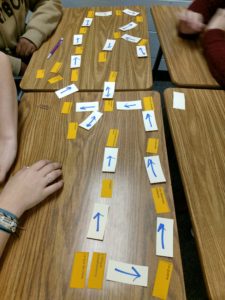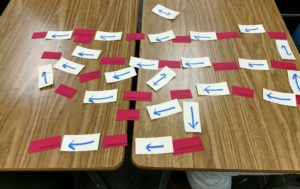My work with language teachers this summer has been one of the most humbling experiences of my career. I see your sacrifice, dedication and courage in impossible situations and I’ve spent some time thinking about how I might help a little bit.
Since I’ve heard a few teachers (especially our valued newbies) mention how much they were struggling to find time to create a curriculum for their upper levels, I decided to start there. I think that many of us face planning challenges with that group. Due to the smaller numbers, we often find our level 3s and 4s or 4s and 5s (or all of the above!) mixed together. We might even find ourselves with one single student whom we so want to provide an independent study for but just don’t have enough hours in the day. The pandemic, of course, adds the nearly insurmountable problems of having to provide a curriculum for distance learning, hybrid learning and face to face learning (while keeping these faces from getting too close).
While I cannot do nearly as much to help as I would like, I have spent some time during the last week or so working on a mini-unit that I thought might provide a jumping off point for some of you.
For this mini-unit, rather than a typical content-based theme, I chose to design my activities around the first episode of the French cartoon Lou! . I was introduced to this program through my position with FluentKey where I’ve been working on transcribing and creating quizzes for the episodes. (It will take a while, I’m only on episode 14!) I would have loved to use this series with my own students–the characters are diverse, the main character’s family is non-traditional (in many ways) and the series addresses issues that affect adolescents in an engaging way. Although the episodes have recurring characters, each one could stand alone if necessary. As a result, I thought a mini-unit on the first episode could be used regardless of the regular curriculum, or with independent study students, or with the students who can’t be in school if you’re face to face, or with that small group of level 4’s that got put in with your level 3s or any of the myriad unimaginable challenges that you’re facing.
So feel free to skip to the link at the bottom, because I’m about to get pretty wordy as I describe the process I used to create the unit for any of you that might like to create units of your own for other episodes.
An Essential Question: I started here because backward design just makes sense to me and helps me frame my work.
Can-Do Statements: I created one Can-Do for each mode of communication based on the NCSSFL-ACTFL Intermediate benchmarks.
Avant de visionner: I included a few discussion questions to use as an advance organizer before introducing the video. These questions could be discussed in-class, via videoconference, in writing using an LMS, etc.
Vocabulaire: I selected ten vocabulary terms from the video and used pictures to introduce them.
Choisissez le bon mot: I created a matching activity in which students will select the word that corresponds to the French definition. This activity can be completed on paper, inserted into a Google Doc, or made into an online quiz using an LMS or other platform.
Regardez la vidéo: I’ve included a link to the FluentKey video for teachers that want to assign the video to students and use a quiz or play FluentKey live with the video. This could be played in-class or via video conference (link to directions is included in teacher notes). I’ve also included a YouTube link. Depending on the proficiency level of the students, I might play the video once, narrating and questioning to increase comprehension. This could be done in class or via videoconferencing. For other students, I would just assign the FluentKey video as an independent activity or assessment.
Remplissez ce schéma: I’ve included a story map graphic organizer for students to fill out about the video. I’ve included a link to a version of the map that can be completed online in the teacher resources at the end of the document.
Remplissez le résumé avec la forme correcte du verbe: I created a one-page summary of the video and left blanks for the students to fill in the correct form (imparfait, passe compose or plus-que-parfait [1] ). I included a key in the teacher resources. This activity could be completed on paper or put in a Google Doc for submitting online. Teachers could also quickly make a multiple choice version as an assessment or way of providing immediate feedback using an appropriate program/LMS.
Mots Croisés à deux: My students loved these partner crosswords! In the teacher notes you’ll find an A puzzle (with the vertical answers filled in) and a B puzzle with the horizontal answers filled in. There are no clues included, as the students use circumlocution to help their partner fill in their missing words. This activity serves as a fun review of the story, as the words in the puzzle are related to key events from the video. In the teacher notes I included an editable version of the puzzle that teachers could send out so that students could complete this activity via Google Meets or Zoom, recording and submitting if possible. Otherwise, the puzzle could be printed for in class use. I’ve also included a rubric for assessing the students if this is possible in your situation.
Citations à discuter: In this section you’ll find a list of quotes from the video as well as a list of discussion questions. I’ve found that this type of activity is an engaging way to review the video. If I were spending a few days on the episode, I might have the students discuss 6-7 questions a day. These discussions could take place face to face, via videoconference or in writing using a discussion board.
Comparaison Culturelle: I’ve created a graphic organizer which the students will complete to compare their lives to Lou’s. I’ve included an editable version in the teacher’s notes for online submission.
Lecture: Students will complete this simple graphic organizer to demonstrate comprehension of an article about journal writing. (Link and rubric included in teacher materials.)
Jeux de Rôles: I’ve included 3 different role plays based on the video. In my classroom, I would usually have the students practice each role play at least twice (changing roles) and often changing partners. I would then call up an unannounced pair and randomly assign a role play for assessment purposes. This ensured a more spontaneous conversation. In a virtual environment, I would have students practice via break out room or have them call each other on the phone. Then I would assign them a 3-minute Zoom conference for the assessment, if that were possible in my particular situation. In the teacher notes I also included a series of phone messages that could be used as speaking assessments if necessary. While these would not be interpersonal tasks, they would allow you to at least have a speaking prompt to assess. They could even be submitted via Flipgrid and classmates could respond as the character who listened to the message.
Journal Intime: You’ll find 3 different prompts based on the video. I generally allowed students to pick the one that most interested them. Having 3 prompts allows the teacher options if they find a student needs to redo the activity for any reason. (I’ve included wording in my rubrics to clarify why students might need to redo an assessment.)
Bonus Activity: This activity, found in the teacher notes, includes the time stamp and a description of a scene from the video so that a teacher could take screenshots from important scenes for discussion activities. I’ve included discussion questions if you choose to include this activity. A teacher could also use the screenshots and questions to assess a student individually, asking follow up questions and personalized questions to create a more developed conversation. Lastly, students could also respond orally or in writing via an LMS for an online environment.
Whew! Congratulations for making it to the end! Here’s a link to the document:
https://docs.google.com/document/d/1Toshc6cHGmbzqNYy_SK4HX2-K7mlPPKA26n5wKi8e8U/copy
As always, I’d love to hear your feedback and answer any questions you have about this mini-unit.
I’ve completed similar mini-units for Episodes 2 and 3 and listed them on Teachers Pay Teachers for those teachers that may not have time to create their own:
If I find that these resources are useful, I will continue to create and post additional episodes.
Image Credit: https://www.needpix.com/photo/1557297/problem-solution-help-support-information-problem-solution-assistance-question-mark-note












